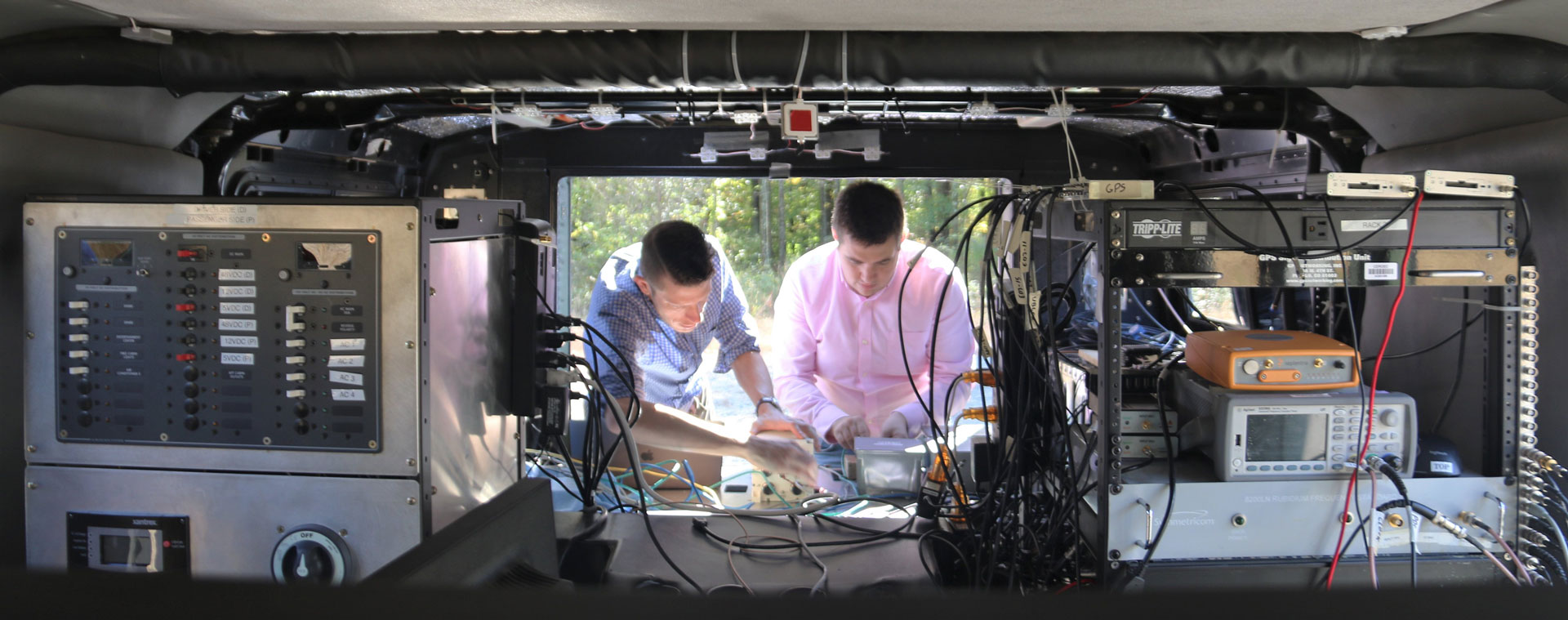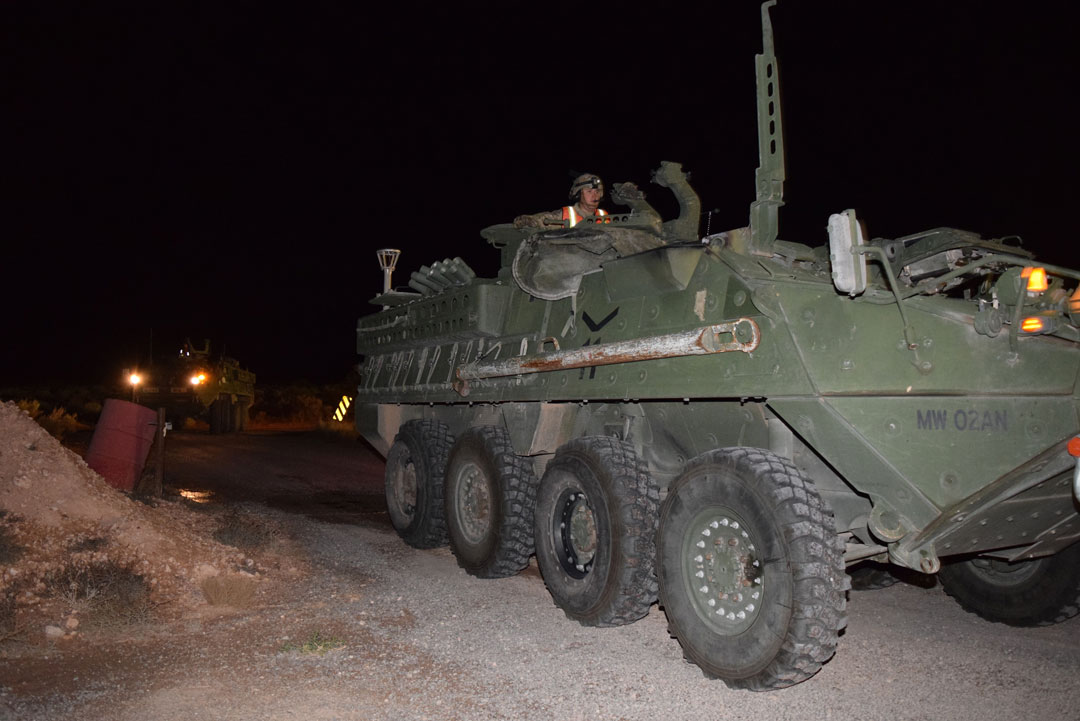
REAL-WORLD TEST: During PNTAX, developers and Soldiers assessed how more than 80 mounted, dismounted and NAVWAR capabilities and systems operated within a replicated real-world, anti-access and area-denied environment. (Photo by U.S. Army)
The eighth in a series of articles on how the Combat Capabilities Development Command is supporting the Army’s six modernization priorities.
by Maj. Gen. John A. George
Maj. Gen. John A. George is the commanding general of the U.S. Army Combat Capabilities Development Command
GPS is among the most important technologies Soldiers rely on during missions. It allows the real-time flow of information that Soldiers need to form a picture of the battlefield and make informed decisions. GPS also plays a critical role in artillery and aviation platforms supporting Soldiers on land and from the air. Potential adversaries are aware of our reliance on GPS, however, so the Army has to be prepared to operate in environments where the technology has been degraded or denied by enemy action.
To that end, the Army has made one of its six modernization priorities to develop assured positioning, navigation and timing—commonly referred to as APNT—to aid Soldiers in maneuvering the battlefield with greater certainty and situational awareness. APNT synchronizes radio communications and the network with intelligence systems. APNT technologies will ensure our military continues to operate in contested environments and dominate our adversaries.
The U.S. Army Combat Capabilities Development Command’s (CCDC) C5ISR Center leads our science and technology initiatives to deliver new APNT capabilities to Soldiers. As a major subordinate command of the Army Futures Command, CCDC’s mission is to use its global team of researchers, engineers, scientists and analysts to provide a world-class scientific and technological foundation for the Army modernization enterprise.
C5ISR (Command, Control, Communications, Computers, Cyber, Intelligence, Surveillance and Reconnaissance) works closely with other CCDC organizations including the Armaments Center, the Army Research Laboratory and the Aviation & Missile Center, as well as the APNT Cross-Functional Team. C5ISR also has science and technology representatives within the APNT Cross-Functional Team. The CCDC centers collaborate continuously with the APNT Cross-Functional Team to discuss current projects, issues and plans for the future and to ensure efforts are aligned with the cross-functional team road map. In May, the APNT team was also one of eight cross-functional teams to take part in the first CCDC-cross-functional team home-on-home meeting, in which partners share plans and priorities and work to align their efforts.
“The APNT [Cross-Functional Team ] is in the process of evaluating various technologies in the areas of APNT, tactical space and NAVWAR [navigation warfare], which will make Army systems more resilient and secure, ensuring future generations of America’s Soldiers get what they need, when they need it, and remain the most lethal and effective land force in the world,” said APNT Cross-Functional Team Director William Nelson.

MISSION CRITICAL: C5ISR Center staff conduct research on position, navigation and timing systems at Aberdeen Proving Ground, Maryland, on Oct. 23, 2019. The systems are critical for Soldiers to maneuver the battlefield with certainty and situational awareness. (Photo by Dan Lafontaine, C5ISR Center)
EXECUTING MISSIONS ON LAND AND IN THE AIR
Our C5ISR team has several projects underway to help Soldiers execute their missions with greater certainty, including the Modular GPS Independent Sensors project. This project enables new position, navigation and timing technologies to be added to existing Army air, ground and Soldier platforms quickly and easily as they become available. The plug-and-play framework uses published standards open to government and industry, which will enable the Army to keep pace with innovation and provide Soldiers with the latest technology more quickly. The open architecture will enable rapid development and upgrades to position, navigation and timing systems, sensors and algorithms as technology matures. C5ISR signed a technology transition agreement with Project Manager Positioning, Navigation and Timing (PM PNT), within the Program Executive Office for Intelligence, Electronic Warfare and Sensors (PEO IEW&S), in fall 2019 to advance a modular GPS independent sensor solution to the field.
Recent history has shown the importance of providing Soldiers with GPS that is reliable and resilient. Soldiers in Afghanistan rely heavily on GPS, but the mountainous terrain inhibits signals, limiting Soldiers’ ability to communicate.
The C5ISR Navigation Warfare project, or NAVWAR, will benefit both Soldiers and commanders by providing a common operating picture of the battlefield. The plug-in solution will fuse data from ground, air and space sensors and provide real-time information for mission planning, as well as more effective electronic protection measures. Components of the NAVWAR project will transition to both PM PNT and Project Manager Electronic Warfare & Cyber, also within PEO IEW&S.
PNT is a critical enabler achieving the five requirements for accurate fire, the highly technical and very specific data that artillery units must continually update in order to use their most accurate and advanced weaponry. PNT is also required for the digital kill-chain sequence, where each link is vital to obtain lethal capability for Army fires.
Our Armaments Center collaborates closely with Joint Program Executive Office for Armaments and Ammunition (JPEO A&A), PEO Missiles and Space, PM PNT, the APNT Cross-Functional Team, Long Range Precision Fires Cross-Functional Team and others to develop advanced APNT technologies for current and next-generation long-range artillery munitions and armaments.
The Armaments Center also leverages the expertise of industry, academia and other DOD services to integrate best-of-breed PNT technologies, with a specific focus on next-generation cannon artillery. These technologies include alternative navigation, anti-jam and anti-spoof, M-Code receivers, image-based terminal guidance, and gun-hardened inertial measurement units. M-Code is a GPS signal designed by the Air Force to improve security and provide anti-jamming capabilities for military GPS. Alternative navigation technologies will enable precision-guided munitions and weapons to utilize non-GPS signals to augment PNT data in a GPS-degraded or denied environment. Anti-jam and anti-spoof and M-code receiver technologies will protect weapons and munitions from hostile attempts to counter our APNT solutions. Gun-hardened inertial measurement units and image-based terminal guidance will enable guided munitions to be more precise by using a variety of sensors and visual cues to adjust the munition’s trajectory onto the target.
Ultimately, these technologies will feed into programs within JPEO A&A’s portfolio, which includes precision-guided munitions and indirect fire weapon systems. CCDC’s work modernizing these technologies will enable the Army to conduct precision strikes and maintain battlefield dominance and lethality while operating in a GPS-denied or -degraded environment.
APNT solutions for aviation and missile systems will support the critical role Army aviation plays in military operations. The Aviation & Missile Center is working on projects to integrate and test M-Code GPS receivers and anti-jam electronics on the Patriot launcher and Gray Eagle unmanned aircraft system. The integration of M-Code GPS receivers into Army platforms will not only increase our APNT capability, it will also improve joint operations that are critical to the success of the Army’s multi-domain operations concept.
Meanwhile, CDCC’s Army Research Laboratory (ARL) is leading a holistic approach to enable GPS-free APNT for dismounted Soldiers, including precise time and exquisite positioning without access to globally networked information. This will enable units that are separated in battle to function as a cohesive whole and complete their missions. The typical ARL timeline for these technologies has been substantially accelerated to deliver prototypes for Soldier testing within a few years. Key to this effort are Soldier touch point events in which the ultimate users have an opportunity to evaluate the prototypes and make recommendations early in the development process. This helps the Army can deliver better capabilities more quickly.

IN THE FIELD: Soldiers from I Corps, U.S. Army Europe, the Colorado and New Mexico National Guards, U.S. Army Special Operations Command, Joint Special Operations Command and the Army Cyber Directorate participated in the PNT Assessment Exercise, or PNTAX, at White Sands Missile Range, New Mexico, in July and August 2019. (Photo by U.S. Army)
PUTTING TECHNOLOGY IN SOLDIERS’ HANDS
Testing technologies at field exercises that simulate battlefield conditions is one key to the success of the APNT capabilities we are currently developing. We achieved this during the PNT Assessment Exercise, or PNTAX, at White Sands Missile Range, New Mexico, in July and August 2019. Thirty-four Soldiers from I Corps, U.S. Army Europe, the Colorado and New Mexico National Guards, U.S. Army Special Operations Command, Joint Special Operations Command and the Army Cyber Directorate participated in the event.
White Sands Missile Range is one of a few real-world settings where Soldiers can test capabilities in a GPS-denied or -degraded environment. During the exercise, developers and Soldiers assessed how more than 80 mounted, dismounted and NAVWAR capabilities and systems operated within a real-world, anti-access and area-denied environment. The information we collected is helping us understand how developing systems perform and how they can significantly improve Soldier operations in GPS-contested environments.
We also conduct other Soldier touch point events throughout the year, including technology demonstrations, capability assessments and live-fire and training exercises. Our scientists and engineers gather feedback through these touch points that ultimately influence how CCDC matures technology to get it ready to transition to our partners. We gain vital insight to ensure new systems will be operationally successful by putting prototypes and systems directly into the hands of Soldiers.
CCDC works with hundreds of nontraditional defense companies, industry and academia partners to capture emerging technologies and refine APNT capabilities. One of the challenges, however, is testing commercial products on the military network. Later this year, we plan to launch the Open Innovation Lab, or OIL, at Aberdeen Proving Ground, Maryland. OIL will enable our industry partners to test their technologies in an unclassified lab with an open architecture. An open architecture not only fosters competition among vendors, it also accelerates innovation by providing a steady flow of information.
CONCLUSION
CCDC is sharing information gathered from our partnerships with industry and academia and from Soldier touch point events so we can refine requirements, develop technologies to fill capability gaps and accelerate timelines to field technology more quickly. Equipping Soldiers with the most advanced APNT technology will give them a critical advantage on the battlefield and enable them to fight and win against any adversary.
For more information, go to www.army.mil/ccdc.
MAJ. GEN. JOHN A. GEORGE is the commanding general of CCDC. Before assuming command of CCDC, he served as deputy director and chief of staff of the U.S. Army Futures Command Futures and Concepts Center. He graduated from the United States Military Academy at West Point and was commissioned into the Army in 1988. He has an M.S. in social psychology from Penn State University and an M.S. in national resource strategy from the Industrial College of the Armed Forces, which is now known as the Eisenhower School for National Security and Resource Strategy.
Read the full article in the Fall 2020 issue of Army AL&T magazine.
Subscribe to Army AL&T News – the premier online news source for the Army Acquisition Workforce. ![]() Subscribe
Subscribe







